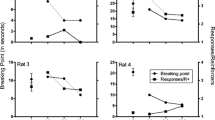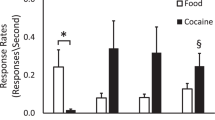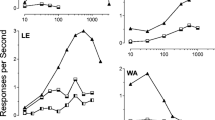Abstract
Cocaine (0.1 or 0.3 mg/kg/h) was infused continuously from osmotic minipumps during 14-day periods in three squirrel monkeys trained under a fixed-interval schedule of stimulus-shock termination. Chronic exposure to 0.1 mg/kg/h cocaine increased response rates during control sessions for two subjects, and rates returned to pre-infusion levels after the osmotic minipumps were removed. During chronic administration with 0.3 mg/kg/h cocaine, tolerance developed to the gross behavioral effects observed initially in all subjects and to the rate-suppressing effects observed in one subject. Using a cumulative-dosing procedure, cocaine was administered IV acutely once per week before, during and after each chronic administration with cocaine. The acute effects of cocaine on schedule-controlled responding before chronic administration and during chronic exposure to 0.1 and 0.3 mg/kg/h cocaine were similar, providing no evidence of sensitization or tolerance.
Similar content being viewed by others
References
Bergman J, Hassoun J, Schuster CR (1985) Behavioral effects of selected opiates and phencyclidine in the nondependent and cyclazocine-dependent rhesus monkey. J Pharmacol Exp Ther 235:463–469
Bergman J, Schuster CR (1985) Behavioral effects of naloxone and nalorphine preceding and following morphine maintenance in the rhesus monkey. Psychopharmacology 86:324–327
Gollub LR (1964) The relations among measures of performance on fixed-interval schedules. J Exp Anal Behav 7:337–343
Gonzalez FA, Goldberg SR (1977) Effects of cocaine and d-amphetamine on behavior maintained under various schedules of food presentation in squirrel monkeys. J Pharmacol Exp Ther 201:33–43
Herd JA, Morse WH, Kelleher RT, Jones LG (1969) Arterial hypertension in the squirrel monkey during behavioral experiments. Am J Physiol 217:24–29
Herrnstein RJ, Morse WH (1957) Effects of pentobarbital on interminttently reinforced behavior. Science 127:929–931
Hinson RE, Poulos CX (1981) Sensitization to the behavioral effects of cocaine: modification by Pavlovian conditioning. Pharmacol Biochem Behav 15:559–562
Howell LL, Byrd LD, Marr MJ (1986) Similarities in the ratealtering effects of white noise and cocaine. J Exp Anal Behav 46:381–394
Kelleher RT, Goldberg SR (1979) Effects of naloxone on schedulecontrolled behavior in monkeys. In: Usdin E, Bunney WE Jr, Kline NS (eds) Endorphins in mental health research. Oxford University Press, New York, pp 461–472
McMillan DE, Harris LS, Frankenheim JM, Kennedy JS (1970) 16-1 in pigeons: tolerance to the behavioral effects. Science 169:501–503
Post RM, Rose H (1976) Increasing effects of repetitive cocaine administration in the rat. Nature 260:731–732
Post RM, Contel NR, Gold P (1982) Impaired behavioral sensitization to cocaine in vasopressin deficient rats. Life Sci 31:2745–2750
Post RM, Lockfeld A, Squillace KM, Contel NR (1981) Drugenvironment interaction: context dependency of cocaine-induced behavioral sensitization. Life Sci 28:755–760
Roy SN, Bhattacharyya AK, Pradhan, S, Pradhan SN (1978) Behavioral and neurochemical effects of repeated administration of cocaine in rats. Neuropharmacology 17:559–564
Schuster CR, Dockens WS, Woods JH (1966) Behavioral variables affecting the development of amphetamine tolerance. Psychopharmacologia 9:170–182
Spealman RD (1979) Comparison of drug effects on responding punished by pressurized air or electric shock delivery in squirred monkeys: pentobarbital, chlordiazepoxide, d-amphetamine, and cocaine. J Pharmacol Exp Ther 204:309–315
Spealman RD, Goldberg SR, Kelleher RT, Goldberg DM, Charlton JP (1977) Some effects of cocaine and two cocaine analogs on schedule-controlled behavior of squirrel monkeys. J Pharmacol Exp Ther 202:500–509
Spealman RD, Kelleher RT, Goldberg SR (1983) Stereoselective behavioral effects of cocaine and a phenyltropane analog. J Pharmacol Exp Ther 225:509–514
Theeuwes F, Yum SI (1976) Principles of the design and operation of generic osmotic pumps for the delivery of semisolid or liquid formulations. Ann Biomed Eng 4:343–353
Wenger GR (1980) Cumulative dose-response curves in behavioral pharmacology. Pharmacol Biochem Behav 13:647–651
Wood DM, Emmett-Oglesby MW (1986) Characteristics of tolerance, recovery from tolerance and cross-tolerance for cocaine used as a discriminative stimulus. J Pharmacol Exp Ther 237:120–125
Wood DM, Lal H, Emmett-Oglesby MW (1984) Acquisition and recovery of tolerance to the discriminative stimulus properties of cocaine. Neuropharmacology 23:1419–1423
Woods JH, Carney J (1978) Narcotic tolerance and operant behavior. In: Krasnegor NA (ed) Behavioral tolerance: research and treatment implications (NIDA Monograph #18). US Government Printing Office Washington DC, pp 54–66
Woolverton WL, Kandel D, Schuster CR (1978a) Effects of repeated administration of cocaine on schedule-controlled behavior of rats. Pharmacol Biochem Behav 9:327–337
Woolverton WL, Kandel D, Schuster CR (1978b) Tolerance and cross-tolerance to cocaine and d-amphetamine. J Pharmacol Exp Ther 205:525–535
Woolverton WL, Kleven MS (1988) Evidence for cocaine dependence in monkeys following a prolonged period of exposure. Psychopharmacology 94:288–291
Young AM, Griffin AC (1984) Drug history influences development of tolerance to the rate-decreasing effects of morphine. Fed Proc 43:747
Author information
Authors and Affiliations
Additional information
Animals used in this study were maintained in accordance with the guidelines of the Committee on Animals of the Harvard Medical School and of the “Guide for Care and Use of Laboratory Animals” of the Institute of Laboratory Animal Resources, National Research Council, Department of Health, Education and Welfare, Publication No. (NIH) 85-23, revised 1985
Rights and permissions
About this article
Cite this article
Howell, L.L., Morse, W.H. Behavioral effects of chronically administered cocaine in squirrel monkeys. Psychopharmacology 97, 12–16 (1989). https://doi.org/10.1007/BF00443405
Received:
Accepted:
Issue Date:
DOI: https://doi.org/10.1007/BF00443405




